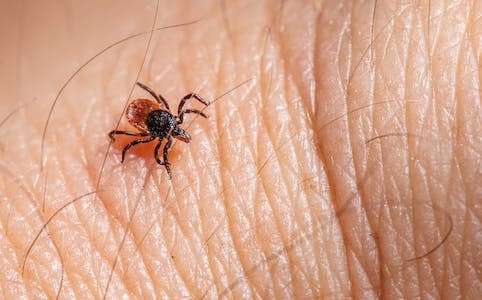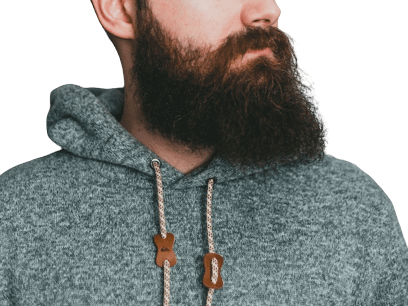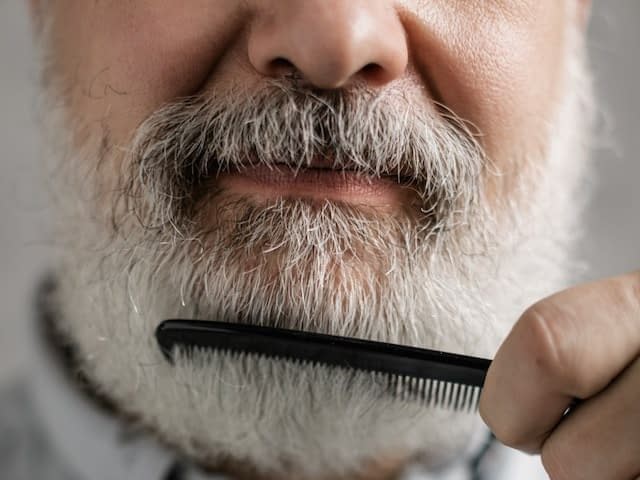Lice, a tiny, parasitic insect that feeds on human blood, is commonly present on the scalp.
But when you feel the same itchiness on your beard, the first thing that comes to mind is, can you get lice in your beard?
The answer is yes. You may get lice in your beards due to physical contact with someone affected or through their belongings, including a hat, comb, or towel.
In addition, beard itching can occur due to various beard problems. It can be beard dandruff, hygiene issues, or dryness, but you may not feel the movement in these cases.
You can use the best products for itchy beards in those cases.
To know more, let us delve into the world of beard lice and understand the nitty-gritty of this situation.
Table of Contents
Understanding lice, types, and habitats:
Lice are tiny, pesky insects commonly associated with scalp hair and feed on human blood. There are three types of lice: head, body, and pubic.

Head lice reside in the head and neck and lay eggs in the base of the hair shaft.
They are 2–3 mm long and move by crawling from one person to another. It occurs due to close contact with a person, especially children.
Body lice are 2.3–3.6 mm long and occur due to unhygienic clothing or crowded places.
People who are homeless or refugees may have a higher risk of body lice.
They reside in clothes and only move to the skin to feed. It can spread from person to person with close contact.
Lastly, pubic lice or crab louse are 1.1–1.8 mm long and found in pubic areas but sometimes in areas with coarse hair like beard, chest, armpits, eyebrows, mustache, and eyelashes.
Pubic lice occur due to sexual contact.
Dogs, cats, and other pets do not play a role in head, body, or pubic lice infestation.
In addition, over-the-counter and prescription medications are available for treating head, body, or pubic lice infestations.
But as they say, prevention is better than cure. Prevent lice in your beard before searching for medication.
You can learn more about their habitat and prevent them from coming.
Lice need a specific environment to live in. If you know the environment where lice reside, you can avoid the occurrence and help in treatment.
Here are some factors that influence lice’ habitat:
Warmth
Lice need a warm environment to survive and reproduce.
The human body, especially the scalp region, is covered with hair, and warmth provides an ideal temperature to develop eggs, survive, and reproduce.
Darkness
Lice prefer the dark for survival, being nocturnal creatures.
Since they stay away from light, places like the genital region, armpits, and scalp are most vulnerable to infestation.
Lives near a Food source
Lice survive on human blood, so they need to stay close to their food source.
That is why they survive on the scalp, an accessible location for grazing three times a day.
Proximity to host
Lice require close intimacy with their hosts to consume food and reproduce.
Hugging, exchanging personal objects, and sharing a bed in proximity are examples of actions that promote this close contact.
Crowded places
Public places like schools, camps, or other densely populated areas have a higher chance of lice infestation.
Lice has a lot of opportunities to spread from person to person in this crowded setting.
Poor hygiene
Infrequent washing or grooming, in particular, contributes to poor personal hygiene and fosters an environment where lice thrive.
Unwashed hair and clothing that hasn’t frequently laundered are ideal habitats for lice.
Sharing personal stuff
Lice can spread through sharing private items such as towels, caps, brushes, and combs.
Lice move effortlessly from one object to another, searching for new hosts.
Clothing material
Body lice are known to contaminate bedding and clothes.
They may lay their eggs and live apart from their host’s body in fabrics and other fibrous materials.
Understanding lice’ habitat is crucial to prevent or control their infestation.
Also, practicing good personal hygiene, avoiding shared items, and addressing infestations can minimize the condition of lice.
How do lice in your beard occur?
Several reasons are there why you get lice in your beard, and knowing how these tiny creatures find their way into facial hair is crucial for prevention.

Here, I have listed a few reasons why lice get into your beard or other body parts:
Close contact with the affected person
It is the most common reason why you get lice in your beard. Beard lice can travel from the affected person to you.
Lice can crawl from one person’s hair to another’s beard through intimate interactions, including hugs, sharing personal stuff, or during close conversation.
Sharing Personal Items:
Lice can travel from surface to surface. Sharing personal stuff like combs, brushes, towels, or even hats can let lice transfer and infest your beard.
Poor Beard Hygiene:
Poor beard hygiene constructs an environment suitable for lice infestation.
If you procrastinate washing, trimming, and brushing your beard, it becomes an attractive habitat for them.
Crowded Spaces:
Being in crowded or confined spaces raises the risk of lice infestation.
In circumstances where close contact is unavoidable, lice can spread quickly from one person to another.
Absence of knowledge:
Some people may be unaware that lice can infest facial hair.
Lice in the beard might emerge due to a lack of understanding about how they spread and how adaptable they are.
Pre-existing Lice Infestations:
There’s a chance that lice, especially head lice, will spread to your beard if you already have them in your hair.
It is more likely to happen when the initial infestation is not treated rightly.
It is easier to take preventative measures when aware of these issues.
Practicing good hygiene, avoiding close contact with infected people, and not sharing personal goods can reduce the chances of lice in your beard.
If you think you may have an infestation, you need to act quickly and treat the problem to stop it from spreading and to ease your discomfort from these intruders.
How do I know if I have lice? Symptoms:
Sometimes, we feel itching due to reasons like dandruff or poor hygiene and think we might have lice in the beard.
Before treating lice, you must be sure of it. Few symptoms confirm lice in your beard.
Persistent Itching:
One of the most common lice symptoms is itching in your beard.
The lice bites can cause allergic reactions to the area, and you feel itchy or inflamed as a body’s response.
The body’s immune system recognizes lice saliva as an allergen and releases the chemical called histamines, which are responsible for inflammatory response.
Red Bumps and Sores:
When you feel itchy, you scratch the affected area, which leads to red bumps or sores.
Unfortunately, intense scratching of the area may give temporary relief, but it breaks the skin, making it vulnerable to infections and prolonging the overall discomfort.
Visible Lice or Nits:
Another common symptom is visible crawling lice or their eggs on the scalp or beard.
Nits are oval-shaped lice eggs that stick to the hair shaft near the skin’s base.
They are usually white, and when you touch them, you feel like tiny knots in the hair.
Irritability:
What if your hands are always on your scalp or beard, itching?
The itching and irritation can lead to irritability. You may feel embarrassed in front of people.
Also, you may feel difficulty sleeping due to itching and irritability.
Presence of Lice in Personal Items:
I know this symptom is annoying when you find lice everywhere and on anything you use, from your comb, brushes, and caps to towels, pillows, and clothes.
Finding lice on your items is a clear example of lice infestation.
They can transfer from one person to another through these items.
Swollen Lymph Nodes:
Lice bites can lead to swollen lymph nodes, especially in the neck or underarm region. It happens due to the body’s immune response to lice bites.
Feeling something crawling on the skin underneath:
It is also one of the most common symptoms of lice in your beard.
You may feel something crawling on the skin. It happens when lice move from one area to another.
Visible Lice Excrement:
Sometimes, you may notice red or black excrement and may mistakenly think of dandruff, but unlike beard dandruff, it is not greasy and comes out easily as flakes.
These specks are clear signs of lice infestation.
Recognizing lice in your beard can help to treat it effectively on time and prevent it from spreading to others.
Can you get hair lice in a beard?
According to the report, you can get hair lice in a beard.
While head lice are the most commonly known type, you may also get affected by pubic lice or body lice, which specifically attack a few areas, and beards are one of them.
Head lice can spread from one person to another by using their stuff like combs, hats, or towels or through head-to-head contact.
They cannot jump, fly, or catch animals.
The head lice always find a warm, dark area and prefer to lay eggs on hair roots or the scalp.
The egg incubation time is 7-10 days, and within seven days of hatching, nits become mature and ready for reproduction.
The life span of head lice is 40 days when on the head and consumes human blood but can die within two days if detached.
You may feel itching within 3-4 weeks of infestation due to the body’s immune response or sensitivity to louse saliva.
People usually treat them using topical solutions provided by the pharmacy.
These solutions help to suffocate head lice and lose their grip on the follicle.
Using wet combing, it smoothly comes out, and you feel relief.
Can pubic lice spread to the beard?
According to the study, public lice or ‘crabs’ can spread to the beard.

While pubic lice are typically associated with the genital area, they can infest other coarse body hair, including the beard, chest, armpits, and legs.
In the study, a man in his twenties felt itching and sensation in the mustache and was affected by pubic lice.
Pubic lice occurred due to his active, oral sexual contact with a female three days before the onset of symptoms.
In the dermoscopy, they find a yellowish deposit on the mustache and red, inflamed skin below the lower lips.
Also, crab-shaped parasites were clutching the hair shafts with thick claws.
Unhatched nymphs and translucent nit casing were also present in the mustache.
In this way, we can conclude public lice can affect beards and mustaches if a person is sexually involved with the affected person.
Also, the study suggests Entomodermoscopy as a rapid diagnostic tool.
How to get rid of lice in your beard?
You need a systematic approach to eliminate adult lice, nymphs, or nits in your beards.
Here’s a step-by-step guide on how to effectively treat and get rid of lice in your beard:

Confirm the Infestation:
Ensure that itching, irritation, or other symptoms belong to lice infestation.
Sometimes bacterial infections, beard dandruff, or dryness can be the reason behind itching, and mistakenly think it’s a lice infestation.
Confirm it by yourself or consult a professional to do it for you.
Use Medicated Shampoo:
The most common yet effective way to keep lice at bay is a medicated shampoo for treating lice.
These shampoos have ingredients like permethrin or pyrethrin, which suffocate the lice and declutch their claws.
First, wet your beards, apply the shampoo thoroughly from roots to ends, and massage it for the recommended duration.
Rinse the shampoo under the flowing faucet. After rinsing, use a fine-toothed comb to remove dead lice and nits.
Comb through the beard section by section, ensuring you cover all areas.
If you think the whole treatment is required again, you can reapply and wash your beard, followed by combing to ensure complete elimination.
Wash Personal Items:
Wash all personal items that may have come in contact with lice, including comb, hats, bedding, towels, and clothing.
Use hot water and high heat settings for drying to kill any remaining lice or nits.
Avoid Sharing or using other’s Items:
We usually share or use basic things, including combs, brushes, caps, or towels.
But using or sharing this item can result in re-infestation of lice. You have to break the cycle of transmission.
Maintain Beard Hygiene:
Adopt a regular beard hygiene routine. Wash and groom your beard regularly to prevent the recurrence of lice infestations.
Consult a Healthcare Professional:
If over-the-counter treatments do not work or the infestation is severe, consult a healthcare professional for guidance.
They may recommend prescription medications or other suitable interventions.
Remember, consistency and thoroughness are keys to eliminating lice in your beard.
If you have concerns or questions, seeking guidance from a healthcare professional will ensure that you receive appropriate and effective treatment.
Conclusion:
Lice may infest your facial hair. However, it’s imperative to be watchful in upholding proper cleanliness, avoiding close contact, and acting quickly to address any infestation indicators.
You may empower yourself to control and prevent lice in your beard and guarantee a clean and comfy facial hair experience by knowing the causes, symptoms, and efficient treatment techniques.
FAQs:
Can Bald Men With Beards Get Head Lice?
Bald men with beards can get head lice if the lice infest the beard. Shaving can prevent pubic lice, although they could still be around. Beard trimming is not required; some solutions work. Natural therapies such as neem or tea tree oil may help fight pubic lice.
Can pubic lice live if you shave?
Shaving can remove pubic lice, but nits (eggs) may still be on the hair shaft. However, shaving may interfere with the life cycle of pubic lice and lessen the chance of an infestation because they need coarse hair to lay eggs. Shaving must be combined with other treatments to ensure total eradication and stop re-infestation.
Do I have to shave my beard if I have lice?
You are not strictly required to shave your beard if you have lice. Lice can be removed with efficient treatments like medicated shampoos and good hygiene habits. Although shaving is a personal preference, there are other options.
What kills pubic lice naturally?
Natural remedies like tea tree oil, neem oil, olive oil, and eucalyptus oil can help to combat pubic lice as some of them have anti-parasitic properties, and they suffocate lice that you can easily remove through combing.
Consult a healthcare expert before using natural remedies effectively.
Kayden is an entrepreneur, writer, hairstylist working in a professional salon. He specializes in men’s grooming. He loves to blog about beards, hairstyles, and skincare.
